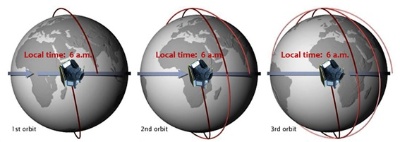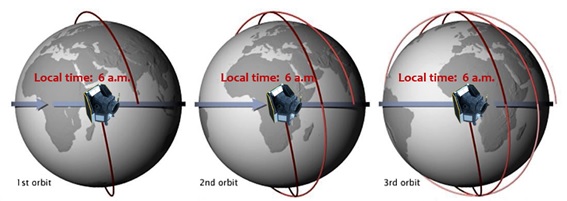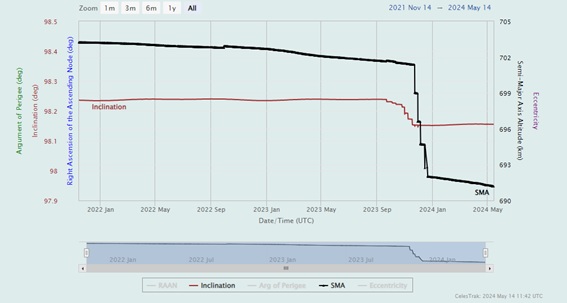- 5/22/24 11:34 AM
- María José González Bonilla

CHEOPS is an astronomical mission dedicated to studying exoplanets orbiting their host star with a Ritchey-Cretien telescope by taking advantage of the platform’s high precision pointing. The satellite is located in a polar low Earth orbit (LEO) at a height of 700 km. Since these types of orbits are so close to Earth, they are affected by the fact that it is not a perfect sphere. The most prevalent affect is that the orbital plane of these satellites rotates around the Earth’s poles at a velocity which primarily depends on the height and the inclination of the orbit.
For CHEOPS, the height and the inclination were selected in such a way that the orbit is sun-synchronous; those whose plane rotate around the pole at the same apparent speed as the Sun around the Earth, in such a way that the angle between the Sun and the orbital plane is constant with time. This has many advantages when it comes to designing a mission, for example, it is very easy for the solar panels to face the Sun without the need of a pointing mechanism, because the Sun is always in the same direction.
Given that the angle between the Sun and a point on Earth is the “time” (before clocks came into play), these orbits cross the equator at the same local time. In reality, they pass above each latitude point at a fixed local time, but the equator is the standard reference. A comprehensible way to express how much the actual orbit has strayed from the ideal is to measure the error in the local time at which the satellite crosses the equator. In the CHEOPS mission, this time, known as the local time of ascending node (LTAN), must be maintained with a precision of +/- 20 minutes in order to ensure the proper functioning of the telescope with respect to the thermal, power and parasitic light conditions.

Figure 1. LTAN representation
During the launch and early orbit phase (LEOP) in December 2019, the satellite was placed in an orbit whose evolution, due to orbital perturbations, would remain inside the defined LTAN limits for three and a half years. Since the LTAN requirement was guaranteed for the entire nominal mission, which ended in December 2023, CHEOPS’ propulsion system would only be used to perform collision avoidance maneuvers and its deorbiting, which is quite different compared to earth observation missions that require a strict orbital maintenance. It is important to note that the strictest requirements for the mission are found in the attitude control, necessary to comply with the scientific goal, by ensuring the telescope always point away from the Sun, never exceeding 60 degrees to either side of its line of sight.
In March 2023, ESA’s Science Programmme Committee approved a first mission extension until December 2026, with a preliminary approval of a second extension until December 2029. Due to the orbital evolution since LEOP, the LTAN had been getting closer to its limits and at the end of 2023 the defined limit would have been surpassed. In consequence, the need to carry out the first orbit maintenance maneuver campaign, to correct the accumulated effects of the orbital perturbations suffered during the nominal mission, was identified.
The maneuver campaign lasted four and a half months, of which the first month and a half were dedicated to maneuver design, operational procedure creation, operator training and maneuver scheduling, while coordinating with potential collision warnings with other objects. The design of the maneuvers not only took into account the propellant, power and thermal requirements, but it also tried to minimize the impact on the scientific operations and maximize the duration of the mission.
Since the LTAN evolution depends primarily on the height and the inclination, the initial strategy consisted in modifying the velocity of the deviation of this parameter with out of plane maneuvers, perpendicular to the orbit, to change the inclination. Nevertheless, an additional study was conducted that demonstrated that lowering the orbit’s height would reduce the amount of incident radiation on the telescope, without affecting the other aspects of the mission such as power generation, thermal control or orbital evolution. After verifying that the propellant budget margin for the deorbiting would not be compromised, it was then decided to modify the LTAN using a combination of in and out of plane maneuvers, correcting the inclination as well as the height.
The first maneuver took place on September 21st, 2023. It was the first time that out of plane maneuvers were performed and they were of a significantly greater magnitude than the tangential maneuvers needed to avoid collisions that were performed earlier in the mission. Thus, it was decided that the first out of plane maneuvers were to be small with the goal of calibrating them in order to adjust the following maneuvers to the actual behavior of the thrusters, with the goal of reducing pointing and magnitude errors. A total of seven out of plane maneuvers were performed at the descending node, with a total ΔV of 10.5 m/s, which brought the orbit to the target inclination. After the first set, the tangential maneuvers to reduce the orbital height began. Four maneuvers with a total ΔV of 4.5 m/s, two at the perigee and two and the apogee in order to maintain the eccentricity of the orbit. Lastly, two smaller tangential maneuvers with a total ΔV of 0.4 m/s were performed to correct the accumulated errors from the previous ones and as a final adjustment to the desired orbit.
The inclination was reduced by approximately 0.08 degree, the height by 10 kilometers, while using 1.75 kilograms of propellant. With 26 kilograms still available, there is more than enough to face the upcoming years of the mission.
 Figure 2. Semi major axis and inclination evolution
Figure 2. Semi major axis and inclination evolution
Currently, the LTAN rate of change can be seen following the desired behavior. Nevertheless, this evolution in the upcoming years will depend a great deal on the solar activity. We are at peak activity of the current solar cycle, which increases the atmospheric drag in low orbit, causes a decrease of the orbital height and consequently a change in the LTAN. Therefore, the need to perform future correction maneuvers during the extension of the mission will depend greatly on our Sun.
If there is something we know for sure, it is that these months of great effort, early mornings and intensive learning all were more than worth it.
María Fuentes
CHEOPS Operations Engineer








